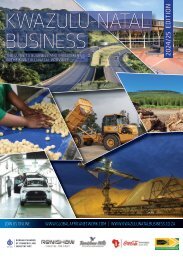Eastern Cape Business 2017 edition
The 2017 edition of Eastern Cape Business is the 10th issue of this highly successful publication that, since its launch in 2006, has established itself as the premier business and investment guide to the Eastern Cape Province. The Eastern Cape enjoys an abundance of natural and human resources, as well as established industrial infrastructure that drives the economy of the province. This includes three ports and two industrial development zones which are home to a wide range of manufacturers and exporters. The 2017 edition includes an in-depth look at the province’s two Industrial Development Zones, a focus on skills development and investment climate information from the Nelson Mandela Business Chamber and the Border-Kei Chamber of Business.
The 2017 edition of Eastern Cape Business is the 10th issue of this highly successful publication that, since its launch in 2006, has established itself as the premier business and investment guide to the Eastern Cape Province. The Eastern Cape enjoys an abundance of natural and human resources, as well as established industrial infrastructure that drives the economy of the province. This includes three ports and two industrial development zones which are home to a wide range of manufacturers and exporters.
The 2017 edition includes an in-depth look at the province’s two Industrial Development Zones, a focus on skills development and investment climate information from the Nelson Mandela Business Chamber and the Border-Kei Chamber of Business.
You also want an ePaper? Increase the reach of your titles
YUMPU automatically turns print PDFs into web optimized ePapers that Google loves.
OVERVIEW<br />
Renewable energy<br />
If the power produced through<br />
the REIPPPP were to be consumed<br />
where it is made, the <strong>Eastern</strong> <strong>Cape</strong><br />
would soon be producing 60%<br />
of its own needs (the power is in<br />
fact sent to the national grid for<br />
redistribution). The province consumed<br />
8 358GWh of electricity in<br />
2015 or 3.7% of the national total.<br />
The average lead time in<br />
the 11 projects that have so far<br />
been approved in the province<br />
is two years, with local content<br />
averaging out at about 47%.<br />
When the projects are complete,<br />
R142.9-billion will have been<br />
spent on procurement, R65.7-<br />
billion of which will be local.<br />
Wind projects in the province<br />
include Globeleq’s 138MW<br />
Jeffrey’s Bay facility, the 140MW<br />
Cookhouse project (African Clean<br />
Energy Developments) and two<br />
run by Cennergi at Tsitsikamma<br />
(94MW) and Bedford (134MW).<br />
Cennergi is a joint venture between<br />
South African resources<br />
company Exxaro and Indian<br />
company Tata Power. There are<br />
a number of other projects with<br />
capacities ranging from 20MW<br />
to 97MW.<br />
Scatec Solar has commissioned<br />
a plant in Burgersdorp. The<br />
75MW plant has panels mounted<br />
on single axes, enabling them to<br />
track the sun and optimise electricity<br />
generation by a further<br />
20%.<br />
The Coega IDZ is working on<br />
positioning itself as a renewable<br />
energy hub. The Department of<br />
Trade and Industry (dti) offers various<br />
green technology incentives.<br />
Electrawinds, Universal Wind and DCD Wind Towers are three RE<br />
companies with a presence in the Coega IDZ.<br />
The energy sector is also creating potential for manufacturers. In<br />
the East London Industrial Development Zone (ELIDZ), for example,<br />
Spanish firm ILB Helios is producing solar panels units for use in the<br />
South African market.<br />
Other<br />
Eskom is pursuing plans for more nuclear power to be added to the<br />
national grid. One of the possible sites is Thyspunt near <strong>Cape</strong> St Francis.<br />
There is strong opposition from archaeologists and environmentalists.<br />
The discovery of shale gas reserves in the Karoo Basin may offer another<br />
opportunity but the topic is almost as controversial as the nuclear option,<br />
as opponents of “fracking”, as the recovery process is called, argue that<br />
underground water supplies might be contaminated.<br />
Small-scale hydropower projects have some potential in deep rural<br />
areas. The largest of the province’s four hydropower stations, Colley<br />
Wobbles in the Mbashe catchment area (maximum capacity 42MW), has<br />
been ineffective due to rising silt levels. The Umzimvubu Dam project is<br />
expected to add power to the grid.<br />
Two bio-digesters have been commissioned in the Keiskammahoek<br />
area. A community training centre runs the project which supplies fertiliser<br />
and gas for cooking.<br />
A bio-ethanol project intended for Cradock has been delayed for<br />
some time by uncertainty about what feedstock to use. The <strong>Eastern</strong> <strong>Cape</strong><br />
Rural Development Agency, supported by the Industrial Development<br />
Corporation, is working on a plan to incentivise producers without<br />
affecting food security.<br />
ONLINE RESOURCES<br />
Coega IDZ: www.coega.co.za<br />
Department of Trade and Industry: www.thedti.gov.za<br />
East London IDZ. www.elidz.co.za<br />
IPP Projects: www.ipp-projects.co.za<br />
National Department of Energy: www.dme.gov.za<br />
Southern African Biofuels Association: www.saba.za.org<br />
South African Photovoltaic Industry Association:<br />
www.sapvia.co.za<br />
South African Renewable Energy Association: www.sarec.org.za<br />
Southern Africa Solar Thermal and Electricity Association (CSP):<br />
www.sastela.org<br />
South African Wind Energy Association: www.sawea.org.za<br />
45 EASTERN CAPE BUSINESS <strong>2017</strong>


















